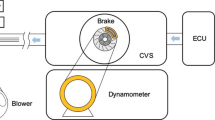Abstract
Automotive and truck brake shoe materials are complex composites of metals, ceramics, and polymers. These are designed to provide stable, reliable frictional performance over a range of vehicle operating conditions, exhibit acceptable wear life, and offer freedom from noise and sensible vibrations. During their use, friction brakes tend to form thin, third-body layers on their contact surfaces. Such tribo-layers play a part in frictional characteristics, and therefore it is of interest to study their structure and properties. This article describes the structure of the friction-induced layers that formed on commercially manufactured brake shoes on a trailer that was subjected to 4 years of highway driving. The layers consist of a thin, brittle crust of nanoscale particulate material that easily delaminates from the substrate. Polished cross sections were studied with both optical and scanning electron microscopy (SEM). Transmission electron microscopy (TEM) of extracted flakes revealed the complex, fine structure of the friction-induced layer. Realistic brake friction models should not use bulk properties of the starting materials, but rather should incorporate the properties of the fine-grained friction layers.
Similar content being viewed by others
References
P.J. Blau: “Compositions, Functions, and Testing of Friction Brake Materials and Their Additives,” Oak Ridge National Laboratory Report ORNL/TM 2001/64, Oak Ridge, TN, 2001.
P.J. Blau: “Frictional Behavior of Automotive Brake Materials Under Wet and Dry Conditions,” Oak Ridge National Laboratory/Ford Motor Company Cooperative Research and Development Agreement, Final Report ORNL/M-5824, Oak Ridge, TN, 1996.
W. Österle, M. Griepentrog, Th. Gross, and I. Urban: “Chemical and Microstructural Changes Induced by Friction and Wear of Brakes,” Wear, 2001, 251, pp. 1469–76.
L. Gudmand-Höyer, A. Bach, G.T. Nielsen, and P. Morgen: “Tribological Properties of Automotive Disc Brakes with Solid Lubricants,” Wear, 1992, 232, pp. 168–75.
T. Kato and H. Soutome: “Friction Material Design for Brake Pads Using Database,” Tribol. Trans., 2001, 44(1), pp. 137–41.
H. Jang, J.S. Lee, and J.W. Fash: “Compositional Effects of the Brake Friction Material on Creep Groan Phemonema,” Wear, 2001, 251, pp. 1477–83.
G. Nicholson: Facts About Friction, Gedoran Publishing, Winchester, VA, 1995.
M. Eriksson and S. Jacobson: “Tribological Surfaces of Organic Brake Pads,” Tribol. Int., 2000, 33(12), pp. 817–27.
A. Wirth and R. Whitaker: “An Energy Dispersive X-ray and Imaging X-ray Photoelectron Spectroscopy Study of Transfer Film Chemistry and Its Influence on Friction Coefficient,” J. Phys. D: Appl. Phys., 1992, 25, pp. A38–43.
P.G. Sanders, T.M. Dalka, N. Xu, M.M. Maricq, and R. Basch: “Laboratory Measurement of Airborne Brake Wear Debris” presented at the 19th Annual SAE Brake Colloquium and Exhibition, New Orleans, LA, Oct 2001, p. 28.
Author information
Authors and Affiliations
Rights and permissions
About this article
Cite this article
Blau, P.J. Microstructure and detachment mechanism of friction layers on the surface of brake shoes. J. of Materi Eng and Perform 12, 56–60 (2003). https://doi.org/10.1361/105994903770343484
Received:
Issue Date:
DOI: https://doi.org/10.1361/105994903770343484




